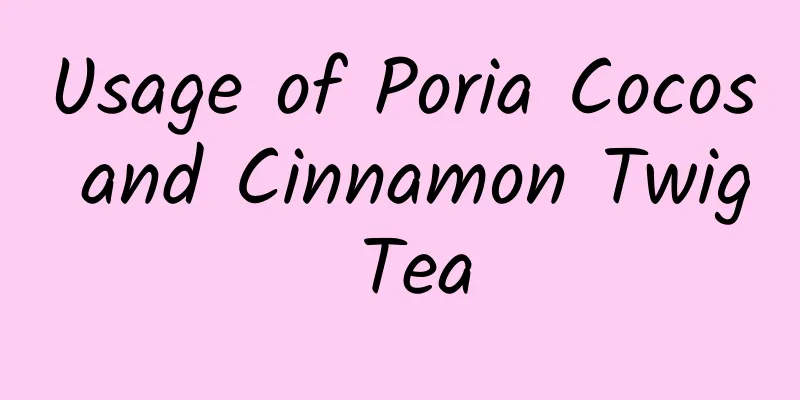Usage of Poria Cocos and Cinnamon Twig Tea

|
In today's social life, we always see many famous and unknown plants, some of which are Chinese herbal plants with extremely high medicinal value. They can be seen as formulas in some Chinese medicinal materials. Some of them we are familiar with, but some we don’t understand. However, they are still contributing to us silently and have many uses. So how to use Poria cocos and cinnamon twig tea? Ingredients: Poria 5g, cinnamon twig 3g, oolong tea 3g. Usage: Brew with 250 ml of boiling water and drink until the taste is light. Function: Warming the Yang, transforming Qi and promoting water circulation. Uses: Palpitations, paroxysmal heart palpitations, and dizziness caused by the upward flow of heart yang; chest tightness, cough, and cold back caused by phlegm and fluid blocking the heart yang; gastric and duodenal bulb ulcer, gastroptosis in patients with weak yang qi; refractory rheumatic heart disease in patients with insufficient heart yang. Source: Traditional medicinal tea recipe. Spleen deficiency diarrhea leucorrhea Poria can both strengthen the spleen and eliminate dampness. It can treat both the symptoms and the root cause of diarrhea and leucorrhea caused by spleen deficiency and dysfunction. It is often used in combination with Codonopsis pilosula, Atractylodes macrocephala, and Dioscorea opposita. It can be used as an auxiliary medicine for nourishing the lungs and spleen and treating qi deficiency. Phlegm and cough Phlegm and dampness enter the meridians, causing sore shoulders and back. Poria can not only promote diuresis and eliminate dampness, but also has the effect of strengthening the spleen. It has a therapeutic effect on the symptoms of spleen deficiency, which is unable to transport and transform water and dampness, and its accumulation and transformation into phlegm and fluid. It can be used together with Pinellia and dried tangerine peel, or with cinnamon twig and Atractylodes macrocephala. It can be used together with Pinellia ternata and Citrus aurantium to treat phlegm and dampness entering the meridians, shoulder and back pain. Palpitations, insomnia, etc. Poria can nourish the heart and soothe the mind, so it can be used for symptoms such as restlessness, palpitations, and insomnia. It is often used in combination with ginseng, polygala, and spinach seed. Anti-cancer It is commonly used clinically to treat esophageal cancer, gastric cancer, liver cancer, nasopharyngeal cancer, tongue cancer, breast cancer, bladder cancer, lung cancer, ulcerative melanoma and other cancers characterized by spleen deficiency and dampness, internal retention of phlegm and fluid, and damp-heat accumulation. Difficulty urinating, edema, etc. Poria cocos has the function of promoting diuresis and eliminating dampness, and its medicinal properties are mild. It can promote diuresis without damaging the body's vital energy, making it an important medicine for promoting diuresis and eliminating dampness. It can be used for any symptoms of difficult urination and stagnant water, regardless of whether they are caused by cold and dampness, dampness and heat, or spleen deficiency and dampness. If the condition is more cold and damp, it can be used with cinnamon twig, white atractylodes, etc.; if the condition is more damp and hot, it can be used with Poria cocos, Alisma orientalis, etc.; if the condition is spleen deficiency, it can be used with Codonopsis pilosula, Astragalus membranaceus, white atractylodes, etc.; if the condition is deficiency-cold, it can also be used with aconite, white atractylodes, etc. After reading the above introduction to the usage of Poria Cocos and Cinnamon Twig Tea, I think everyone should have understood it. There are many uses for Poria cocos and cinnamon twig tea, and it plays a vital role in people's health. We should pay close attention to the relevant knowledge in this area and find suitable ways to improve the symptoms of certain diseases or conditions based on it. |
<<: What are the dietary treatments of Poria cocos?
>>: What are the effects and functions of Rehmannia glutinosa?
Recommend
The role and efficacy of Cynomorium songaricum coffee
As the pace of life continues to accelerate, more...
How long does it take to orbit Mars? The answer is not certain!
(Image credit: Nissian Hughes/Getty Images) Human...
Get more sun, it really can make you happier!
How long has it been since you had a good sun tan...
What are the benefits of drinking deer blood?
We all know that deer blood is of great medicinal...
What are the effects of Chuanbei?
We all know that Chuanbei cough syrup is very eff...
What is the medicinal value of red beans
Red bean is a very good traditional Chinese medic...
Mycorrhizae "weave" networks, forming an "Internet" in the forest
Deep in the dense forest, there is a magical phen...
The efficacy of Kuding tea
Many people like to drink tea. There are many typ...
The efficacy and function of Salvia miltiorrhiza
Salvia miltiorrhiza is rich in nutritional value ...
Curling: From "Stonehenge" to "Rounded Little Boy"
(Picture from the Internet) Curling: The Amazing ...
What can we find from the pig's nose digging the ground? They invented the predecessor of the mask
Under the epidemic, masks have become a necessity...
I heard that eating cassava can help you sleep? Don’t! Be careful of poisoning!
"Cassava helps you sleep. You can sleep for ...
Want to be a behind-the-scenes hero of a super project? Learn more about bridge and tunnel engineering!
Reviewer: School of Civil Engineering, Southwest ...
Why do people use "steel wool" to rub burn wounds? The latest situation of the "burned mother" who moved the whole network →
Recently, Zhuji, Zhejiang Huang's mother was ...
Can a banana a day control blood pressure and reduce the risk of heart disease?
Bananas are a popular fruit with a sweet and smoo...









